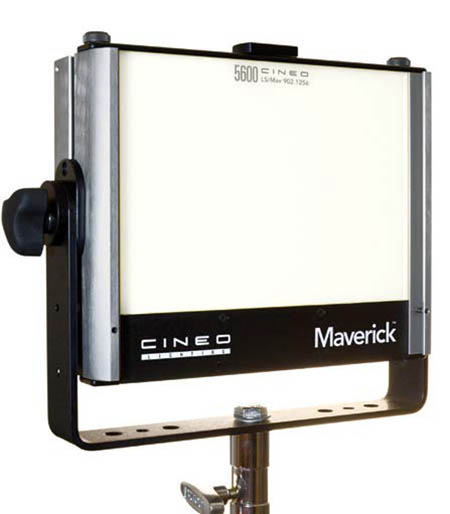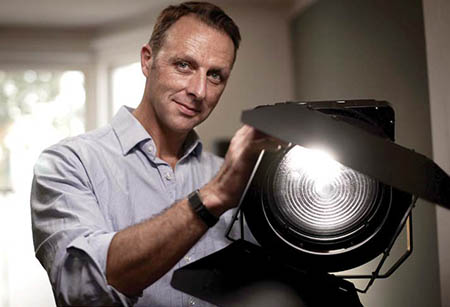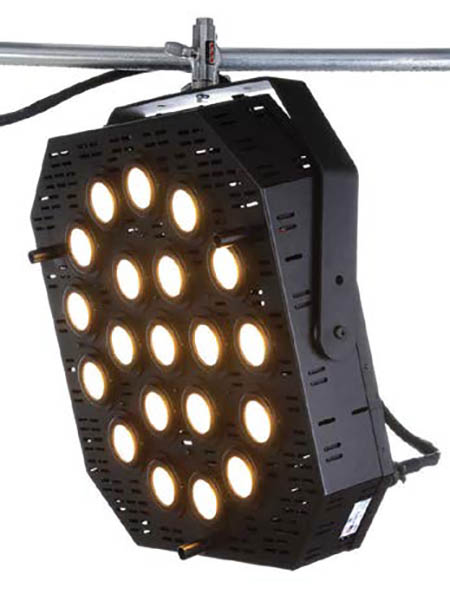Lighting Technology Joins the Digital Age

Cineo Lighting’s Maverick uses the company’s Remote Phosphor Technology in a field light.
BOSTON—While high-profile advancements in cameras, image capture and fancy displays have been stealing the show, motion picture lighting has been left sitting backstage. Yet, lighting technology has been undergoing a steady transformation that may change broadcast and motion picture production more than anything.
For those who haven’t been watching closely, here’s a quick update.
Not long ago, the industry lived in an incandescent bubble. Tungsten lights had been the industry standard since the advent of motion pictures. As digital technologies transformed camera sensitivity and mobility, lighting packages were slow to evolve.
In recent years, alternative lighting technologies were introduced, including fluorescent, halogen, LED (light-emitting diode), and LEP (light-emitting plasma). HMI lights have been a standard for daylightbalanced instruments for decades.
Each lighting alternative enters the market and is evaluated next to the tungsten or HMI standard. The primary goal at this point is to produce a lighting instrument that emulates a tungsten or daylight color profile, is as bright or brighter than existing lights, produces less heat, and requires less power. That’s a list that sounds like the quest for alchemy. But surprisingly, these ambitious goals seem to be within reach.
DOES LED PASS THE TEST?
Get the TV Tech Newsletter
The professional video industry's #1 source for news, trends and product and tech information. Sign up below.
So, who is winning the race? That, of course, depends on whom you talk to. But there seems to be a growing consensus among manufacturers.

Lightworks.TV Ltd. lighting cameraman Scott Munro with the Zylight F8 LED Fresnel.
“LED is here to stay,” said Rich Pierceall, Co-founder and CEO of Cineo Lighting in El Granada, Calif. Cineo Lighting is one of the relatively new companies that are leading the innovation wave of LED lightings so obviously Pierceall has a bias. But his assertion is supported by hard data.
“We are no longer speculating about whether or not LEDs will work,” Pierceall said. “The last few years have proven that the technology is capable of meeting the requirements for broadcast and motion picture.” He points to a long list of productions successfully shot using their LED lighting, including “Gone Girl,” “Blue Jasmine” and “American Idol.”
Creative innovation is transforming the performance of LED lights. The main obstacles have been attaining a smooth color curve, increasing output, and eliminating flicker. Researchers have effectively challenged all of those obstacles.
Cineo Lighting uses a novel concept to improve LED performance. Instead of using LEDs as the light source, they use a method called “remote phosphor,” in which a phosphor panel is excited by LEDs to produce a carefully color balanced light source.
“We have been developing phosphor formulations specific to what a camera sees,” Pierceall said. “We can custom design phosphor formulations that offer all of the color temperatures that anyone could possibly need. Rather than color blending at the LED, we color blend at the phosphor layer. We separate the two pieces so we can dial in the phosphor independent from the LED.”

AAdynTech LED Space Light
NEW FORM OF THINKING
This form of thinking in new ways is driving the advancement of LED lights. Zylight has distinguished their LED lights by offering unprecedented remote control of color temperature. A wireless remote enables a DP to place banks of LEDs on up to 10 separate channels and dial through the full range of color temperatures, dispensing with ladders and gels.
“Our company is growing steadily as people discover what more they can do with LED lights,” said Charlie Collias, senior vice president of worldwide sales for the Los Angelesbased company. “When people see the cost savings they are more apt to adopt LEDs. Their lower temperature saves money on air conditioning, and because you can control the color temperature, you don’t have to buy gels. You save a lot over time by not having to replace expensive lamps.”
HMIs have been the workhorse of outdoor location lighting and are known for an output so high it can simulate sunlight. Companies like AAdynTech are using LEDs to take on the HMI goliath.
“Our mission is to be the lightest and brightest and replace HMIs with LEDs,” said John O’Keefe, director of business development at AAdynTech in Paramus, N.J. “People want a powerful alternative to HMIs. We are at the point now where we can replace the smaller ones, up to 2.5kW. But we’re making progress.”
There has also been a lot of progress on other fronts, such as eliminating flicker, which causes a problem when shooting high-speed footage. Advances in lenses and light beam control have made highly focused light fixtures, such as LED Fresnels a common sight on the LED market.
Compared to the other horses in the light race, LED technology is taking a clear lead. LEP lighting, which uses a technology that induces plasma to emit light, has faced more hurdles in development and adoption.
“In my opinion, LEP is a difficult beast to tame,” Pierceall said. “It was designed for street lamps. The color temperature varies with heat.”
EDUCATING THE MARKET
So developers have been putting their money into LEDs. And slowly, industry professionals are finding that the new, more sophisticated breed of LED lights really can do the job as well as the traditional lighting instruments.
Sales figures support the assertion that LEDs are gaining traction. A study performed by ElectroniCast Consultants predicts the use of LED professional lights in the broadcast and motion picture industry will increase at an average annual growth rate of 11.3 percent over the next five years.
Pierceall concurs. “We are doubling sales every year,” he said.
However, there are still some headwinds slowing down the adoption of LED lights. “We basically have a slow-to-adopt environment,” Pierceall said. “People like using what they know, and they often have preconceptions about LED lights.”
“There are a lot of inferior quality LEDs on the market,” O’Keefe said. “Some people try them and conclude that LEDs are inadequate. The colors are off, or they flicker. The abundance of inferior LEDs tarnishes the reputation of LED lights overall.”
Pierceall says the industry’s biggest challenge is education. “Every solid-state lighting company will say that education is a big obstacle,” he said.
According to Joel San Juan, a professional cinematographer who teaches in the film program at Boston University, directors of photography are apprehensive about trying out new lighting technologies on a shoot, largely due to the cost.
“Trying things out can be expensive,” San Juan said. “One solution to help encourage adoption of new lighting technologies, such as LEDs, would be to include new products in rental grip truck packages. People could try them out without risking a lot of money in the process.”
A PEEK INTO THE FUTURE
So, what does the future of broadcast and motion picture look like?
A quick look at some of the leading developers of lighting systems offers insight into current use patterns.
Kino Flo, a venerable name brand that has built its reputation on high quality fluorescent lights, has added numerous LED systems to their product line in recent years. Videssence pioneered the use of fluorescent lighting for TV studios and continues to maintain high demand for fluorescent lighting systems. More recently they have moved into LED lights as well. And the success of K5600 Lighting is living proof that HMI remains a major component of the lighting industry, with their products filling a spectrum from 200 to 18,000 Watts.
Taken together, one can see that the current market favors a mix of LED, fluorescent, and HMI instruments.
“In the future, I see more features shot with smaller teams and in shorter times,” San Juan said. “Tungsten is not dead yet. Tungsten will exist because on location it is more efficient for matching existing lighting in interiors. But as LEDs improve, they will become more widely used.”
“We consider the excitation of phosphor to be the most efficient way to achieve the desired light quality,” Pierceall said. “Now we are using blue LEDs to excite the phosphor, but laser may be the next thing to try. I look for lasers to start creeping in as a new light source.”
O’Keefe offers a slightly broader forecast for the future.
“LED and phosphor technology are up and coming,” O’Keefe said. “Fluorescents are still a major player. I don’t think LEDs will replace fluorescents, which have a softer look. Halogens will go away, and the lower wattage HMIs will be replaced by LEDs.”
